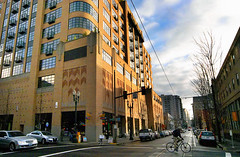A condo building I like (in Portland, Oregon)
Given the continued discussion, in comments too, of the article "The Mediocre Mile," by Philip Kennicott, which appeared in the Monday Post, I've been thinking of posting a photo once/day of quality-designed buildings. I'm not going to, but someone else could...
One of the comments in the earlier entry suggests financial incentives to developers for producing quality. I don't think that developers get money to design attractive buildings in Portland Oregon's Pearl District, they just do it. (And they don't do it in Riverplace, at the other end of the Portland Streetcar line. Why? Probably because the Pearl is being developed by many developers, while I think Riverplace is the domain of one developer, which ends up reducing design variety.) There's average stuff too. But in DC, average is the new excellent-- it's not Lake Wobegon here, at least in the development world.

This photo of the Gregory Building, captioned "11th Ave, View to South, Bike, Street Car Line," is by Miles Hochstein photographer-webmaster of Portland Ground. The full-sized version of the photo is clickable through the link. Miles' website is full of awesome vibrant photos of (mostly) Portland and the region.
Portland allows buildings to be just a little taller than the average DC building--160 feet--although in certain areas DC buildings can get this "high." (It's always disconcerting to go to other cities--except Portland--even small cities like Louisville, and see "skyscrapers" since DC has none.) Plus the blocks are smaller, 200 feet by 200 feet, which makes it hard to construct superbuildings on superblocks, which is another way of homogenizing central business districts.
Index Keywords: urban-design-placemaking



0 Comments:
Post a Comment
<< Home